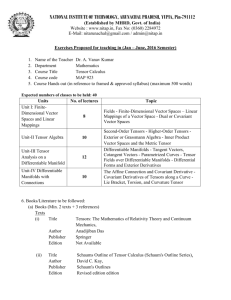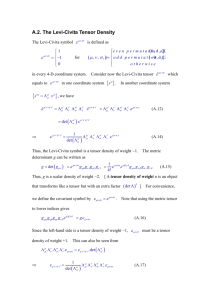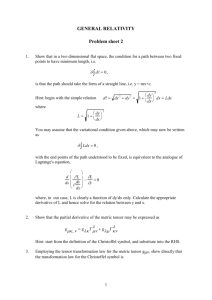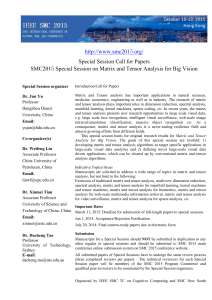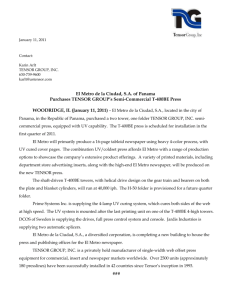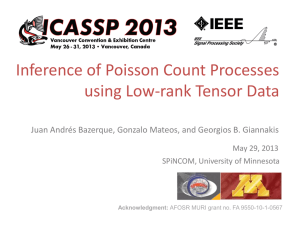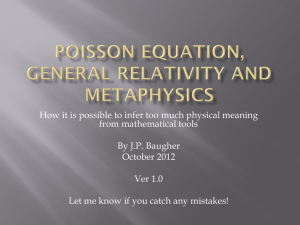Multi-Way Compressed Sensing for Sparse Low-Rank
advertisement
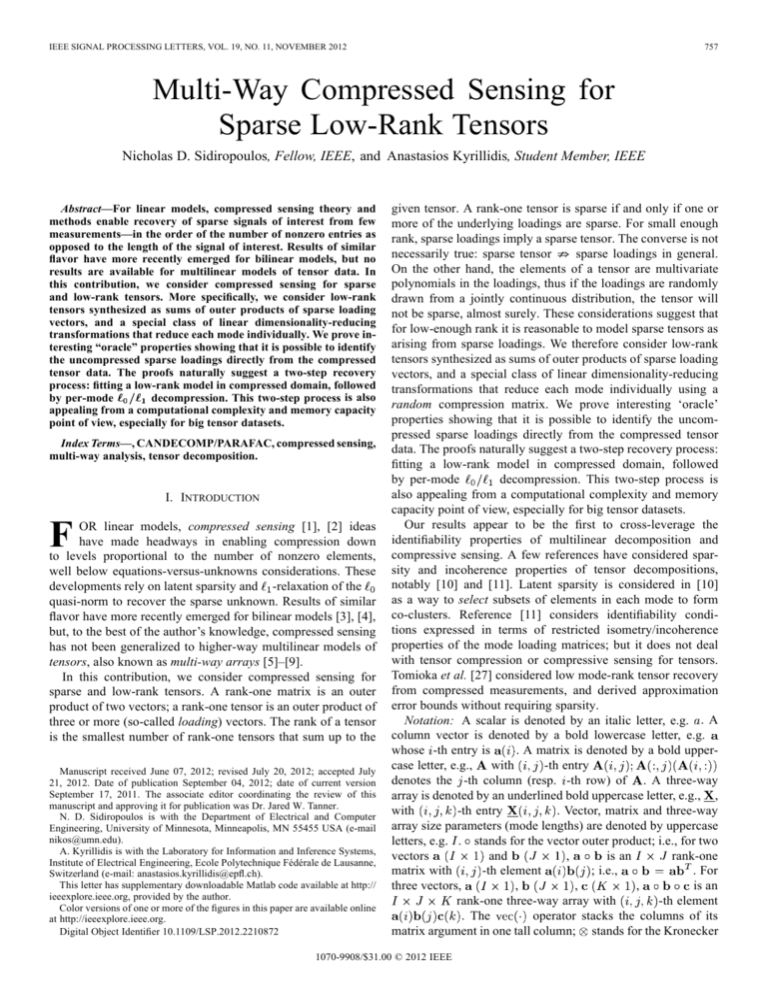
IEEE SIGNAL PROCESSING LETTERS, VOL. 19, NO. 11, NOVEMBER 2012 757 Multi-Way Compressed Sensing for Sparse Low-Rank Tensors Nicholas D. Sidiropoulos, Fellow, IEEE, and Anastasios Kyrillidis, Student Member, IEEE Abstract—For linear models, compressed sensing theory and methods enable recovery of sparse signals of interest from few measurements—in the order of the number of nonzero entries as opposed to the length of the signal of interest. Results of similar flavor have more recently emerged for bilinear models, but no results are available for multilinear models of tensor data. In this contribution, we consider compressed sensing for sparse and low-rank tensors. More specifically, we consider low-rank tensors synthesized as sums of outer products of sparse loading vectors, and a special class of linear dimensionality-reducing transformations that reduce each mode individually. We prove interesting “oracle” properties showing that it is possible to identify the uncompressed sparse loadings directly from the compressed tensor data. The proofs naturally suggest a two-step recovery process: fitting a low-rank model in compressed domain, followed by per-mode decompression. This two-step process is also appealing from a computational complexity and memory capacity point of view, especially for big tensor datasets. Index Terms—, CANDECOMP/PARAFAC, compressed sensing, multi-way analysis, tensor decomposition. I. INTRODUCTION F OR linear models, compressed sensing [1], [2] ideas have made headways in enabling compression down to levels proportional to the number of nonzero elements, well below equations-versus-unknowns considerations. These developments rely on latent sparsity and -relaxation of the quasi-norm to recover the sparse unknown. Results of similar flavor have more recently emerged for bilinear models [3], [4], but, to the best of the author’s knowledge, compressed sensing has not been generalized to higher-way multilinear models of tensors, also known as multi-way arrays [5]–[9]. In this contribution, we consider compressed sensing for sparse and low-rank tensors. A rank-one matrix is an outer product of two vectors; a rank-one tensor is an outer product of three or more (so-called loading) vectors. The rank of a tensor is the smallest number of rank-one tensors that sum up to the Manuscript received June 07, 2012; revised July 20, 2012; accepted July 21, 2012. Date of publication September 04, 2012; date of current version September 17, 2011. The associate editor coordinating the review of this manuscript and approving it for publication was Dr. Jared W. Tanner. N. D. Sidiropoulos is with the Department of Electrical and Computer Engineering, University of Minnesota, Minneapolis, MN 55455 USA (e-mail nikos@umn.edu). A. Kyrillidis is with the Laboratory for Information and Inference Systems, Institute of Electrical Engineering, Ecole Polytechnique Fédérale de Lausanne, Switzerland (e-mail: anastasios.kyrillidis@epfl.ch). This letter has supplementary downloadable Matlab code available at http:// ieeexplore.ieee.org, provided by the author. Color versions of one or more of the figures in this paper are available online at http://ieeexplore.ieee.org. Digital Object Identifier 10.1109/LSP.2012.2210872 given tensor. A rank-one tensor is sparse if and only if one or more of the underlying loadings are sparse. For small enough rank, sparse loadings imply a sparse tensor. The converse is not sparse loadings in general. necessarily true: sparse tensor On the other hand, the elements of a tensor are multivariate polynomials in the loadings, thus if the loadings are randomly drawn from a jointly continuous distribution, the tensor will not be sparse, almost surely. These considerations suggest that for low-enough rank it is reasonable to model sparse tensors as arising from sparse loadings. We therefore consider low-rank tensors synthesized as sums of outer products of sparse loading vectors, and a special class of linear dimensionality-reducing transformations that reduce each mode individually using a random compression matrix. We prove interesting ‘oracle’ properties showing that it is possible to identify the uncompressed sparse loadings directly from the compressed tensor data. The proofs naturally suggest a two-step recovery process: fitting a low-rank model in compressed domain, followed decompression. This two-step process is by per-mode also appealing from a computational complexity and memory capacity point of view, especially for big tensor datasets. Our results appear to be the first to cross-leverage the identifiability properties of multilinear decomposition and compressive sensing. A few references have considered sparsity and incoherence properties of tensor decompositions, notably [10] and [11]. Latent sparsity is considered in [10] as a way to select subsets of elements in each mode to form co-clusters. Reference [11] considers identifiability conditions expressed in terms of restricted isometry/incoherence properties of the mode loading matrices; but it does not deal with tensor compression or compressive sensing for tensors. Tomioka et al. [27] considered low mode-rank tensor recovery from compressed measurements, and derived approximation error bounds without requiring sparsity. Notation: A scalar is denoted by an italic letter, e.g. . A column vector is denoted by a bold lowercase letter, e.g. . A matrix is denoted by a bold upperwhose -th entry is case letter, e.g., with -th entry denotes the -th column (resp. -th row) of . A three-way array is denoted by an underlined bold uppercase letter, e.g., , -th entry . Vector, matrix and three-way with array size parameters (mode lengths) are denoted by uppercase letters, e.g. . stands for the vector outer product; i.e., for two vectors and , is an rank-one -th element ; i.e., . For matrix with , , , is an three vectors, rank-one three-way array with -th element . The operator stacks the columns of its matrix argument in one tall column; stands for the Kronecker 1070-9908/$31.00 © 2012 IEEE 758 product; product. IEEE SIGNAL PROCESSING LETTERS, VOL. 19, NO. 11, NOVEMBER 2012 stands for the Khatri-Rao (column-wise Kronecker) II. TENSOR DECOMPOSITION PRELIMINARIES There are two basic multiway (tensor) models: Tucker3, and PARAFAC. Tucker3 is generally not identifiable, but it is useful for data compression and as an exploratory tool. PARAFAC is identifiable under certain conditions, and is the model of choice when one is interested in unraveling latent structure. We refer the reader to [9] for a gentle introduction to tensor decompositions and applications. Here we briefly review Tucker3 and PARAFAC to lay the foundation for our main result. Tucker3: Consider an three-way array commatrix slabs , arranged into the tall matrix prising . The Tucker3 model (see also [12]) can be written as , where , are three mode loading matrices, assumed orthogonal without loss of generality, and is the so-called Tucker3 core tensor recast in matrix form. The non-zero elements of the core tensor determine the interactions between columns of . The associated model-fitting problem is usually solved using an alternating least squares procedure. The Tucker3 model can be fully vectorized as . PARAFAC: When the core tensor is constrained to be diagonal (i.e., if or ), one obtains the parallel factor analysis (PARAFAC) [6], [7] model, sometimes also referred to as canonical decomposition (CANDECOMP) [5], or CP for CANDECOMP-PARAFAC. PARAFAC can be written in compact matrix form as , using the Khatri-Rao product. PARAFAC is in a way the most basic tensor model, because of its direct relationship to tensor rank and the concept of low-rank decomposition or approximation. In particular, employing a property of the Khatri-Rao product, where is a vector of all 1’s. Equivalently, with denoting the -th column of , and analogously for and , . Consider an tensor of rank . In vectorized form, it can be written as the vector , for some , , and —a PARAFAC model of size and order parameterized by . The Kruskal-rank of , denoted , is the maximum such that any columns of are linearly independent . Given , if , then are unique up to a common column permutation and scaling, i.e., , , , where is a permutation matrix and non-singular diagonal matrices such that , see [5]–[8], [13]–[15]. When dealing with big tensors that do not fit in main memory, a reasonable idea is to try to compress to a much smaller tensor that somehow captures most of the systematic variation in . The commonly used compression method is to fit a low-dimensional orthogonal Tucker3 model (with low mode-ranks) [9], then regress the data onto the fitted mode-bases. This idea [16], [17] has been exploited in existing Fig. 1. Schematic illustration of tensor compression: going from an tensor to a much smaller tensor via multiplying (every slab from the -mode with , from the -mode with , and from the of) -mode with , where is , is , and is . PARAFAC model-fitting software, such as COMFAC [18], as a useful quick-and-dirty way to initialize alternating least squares computations in the uncompressed domain, thus accelerating convergence. Tucker3 compression requires iterations with the full data, which must fit in memory, see also [19], [20]. III. RESULTS Consider compressing into , where is , . In particular, we propose to consider a specially structured compression matrix , which corresponds to multiplying (every slab of) from the -mode with , from the -mode with , and from the -mode with , where is , is , and is , with , , and ; see Fig. 1. Such an corresponds to compressing each mode individually, which is often natural, and the associated multiplications can be efficiently implemented when the tensor is sparse. Due to a property of the Kronecker product [21], from which it follows that i.e., the compressed data follow a PARAFAC model of size and order parameterized by with , , . We have the following result. Theorem 1: Let , where is , is , is , and consider compressing it to , where the mode-compression matrices , , and are randomly drawn from an absolutely continuous distribution with respect to the Lebesgue measure in , , and , respectively. Assume that the columns of are sparse, and let be an upper bound on the number of nonzero elements per column of (respectively ). If , and , , , then the original factor loadings are almost surely identifiable from the compressed data , i.e., if , then, with probability 1, , , , where SIDIROPOULOS AND KYRILLIDIS: MULTI-WAY COMPRESSED SENSING FOR SPARSE LOW-RANK TENSORS is a permutation matrix and non-singular diagonal matrices such that . For the proof, we will need two Lemmas. Lemma 1: Consider , where is , and let the matrix be randomly drawn from an absolutely continuous distribution with respect to the Lebesgue measure in (e.g., multivariate Gaussian with a non-singular covariance matrix). Then almost surely (with probability 1). Proof: From Sylvester’s inequality it follows that cannot exceed . Let . It suffices to show that any columns of are linearly independent, for all except for a set of measure zero. Any selection of columns of can be written as , where holds the respective columns of . Consider the square top sub-matrix , where holds the top rows of . Note that is an analytic function of the elements of (a multivariate polynomial, in fact). An analytic function that is not zero everywhere is nonzero almost everywhere; see e.g., [22] and references therein. To prove that for almost every , it suffices to find one for which . Towards this end, note that since , is full column rank, . It therefore has a subset of linearly independent rows. Let the corresponding columns of form a identity matrix, and set the rest of the entries of to zero. Then for this particular . This shows that the selected columns of (in ) are linearly independent for all except for a set of measure zero. There are ways to select columns out of , and each excludes a set of measure zero. The union of a finite number of measure zero sets has measure zero, thus all possible subsets of columns of are linearly independent almost surely. The next Lemma is well-known in the compressed sensing literature [1], albeit usually not stated in Kruskal-rank terms: Lemma 2: Consider , where and are given and is sought. Suppose that every column of has at most nonzero elements, and that . (The latter holds with probability 1 if the matrix is randomly drawn from an absolutely continuous distribution with respect to the Lebesgue measure in , and ). Then is the unique solution with at most nonzero elements per column. We can now prove Theorem 1. Proof: Using Lemma 1 and Kruskal’s condition applied to the compressed tensor establishes uniqueness of , , , up to common permutation and scaling/counter-scaling of columns, i.e., , , will be identified, where is a permutation matrix, and are diagonal matrices such that . Then Lemma 2 finishes the job, as it ensures that, e.g., will be recovered from up to column permutation and scaling, and likewise for and . Remark 1: Theorem 1 does not require , , or to be . If , , , Theorem 1 asserts that it is possible to identify from the compressed data under the same k-rank condition as if the uncompressed data were available. If one ignores the underlying low-rank (multilinear/Khatri-Rao) structure in and attempts to recover it as a sparse vector comprising up to non-zero elements, 759 is required. For , , and , the latter requires samples vs. for Theorem 1. Remark 2: Optimal PARAFAC fitting is NP-hard [23], but in practice alternating least squares (ALS) offers satisfactory approximation accuracy at complexity in raw space/ in compressed space (assuming a hard limit on the total number of iterations). Computing the minimum norm solution of a system of equations in unknowns entails worst-case complexity [24], [25]. Fitting a PARAFAC model to the compressed data, then solving an minimization problem for each column of has overall complexity . This does not require computations in the uncompressed data domain, which is important for big data that do not fit in memory. Using sparsity first and then fitting PARAFAC in raw space has complexity . If one mode is not compressed under , say , then it is possible to guarantee identifiability with higher compression factors (smaller ) in the other two modes, as shown next. In what follows, we consider i.i.d. Gaussian compression matrices for simplicity. Theorem 2: Let , where is , is , is , and consider compressing it to then , where the mode-compression matrices , , and have i.i.d. Gaussian zero mean, unit variance entries. Assume that the columns of are sparse, and let be an upper bound on the number of nonzero elements per column of (respectively ). If , , , and , , , then the original factor loadings are almost surely identifiable from the compressed data up to a common column permutation and scaling. Notice that this second theorem allows compression down to order of in two out of three modes. For the proof, we will need the following Lemma: Lemma 3: Consider , where is deterministic, tall/square and full column rank , and the elements of are i.i.d. Gaussian zero mean, unit variance random variables. Then the distribution of is absolutely continuous (nonsingular multivariate Gaussian) with respect to the Lebesgue measure in . Proof: Define , and . Then , and therefore , where we have used the vectorization and mixed product rules for the Kronecker product [21]. The rank of the Kronecker product is the product of the ranks, hence . We can now prove Theorem 2. Proof: From [26] (see also [14] for a deterministic counterpart), we know that PARAFAC is almost surely identifiable if the loading matrices are randomly drawn from an absolutely continuous distribution with respect to the Lebesgue measure in , is full column rank, and . Full rank of is ensured almost surely by 760 IEEE SIGNAL PROCESSING LETTERS, VOL. 19, NO. 11, NOVEMBER 2012 Lemma 1. Lemma 3 and independence of and imply that the joint distribution of and is absolutely continuous with respect to the Lebesgue measure in . Theorems 1 and 2 readily generalize to four-and higher-way tensors (having any number of modes). As an example, using the generalization of Kruskal’s condition in [13]: Theorem 3: Let , where is , and consider compressing it to , where the mode-compression matrices are randomly drawn from an absolutely continuous distribution with respect to the Lebesgue measure in . Assume that the columns of are sparse, and let be an upper bound on the number of nonzero elements per column of . If , and , , then the original factor loadings are almost surely identifiable from the compressed data up to a common column permutation and scaling. IV. DISCUSSION Practitioners are interested in actually computing the underlying loading matrices . Our results naturally suggest a two-step recovery process: fitting a PARAFAC model to the compressed data using any of the available algorithms, such as [18] or those in [9]; then recovering each from the recovered using any estimation algorithm from the compressed sensing literature. We have written code to corroborate our identifiability claims, using [18] for the first step and enumeration-based decompression for the second step. This code is made available as proof-of-concept, and will be posted at http://www.ece.umn.edu/~nikos. Recall that optimal PARAFAC fitting is NP-hard, hence any computational procedure cannot be fail-safe, but in our tests the results were consistent. Also note that, while identifiability considerations and recovery only demand that , -based recovery algorithms typically need to produce acceptable results. In the same vain, while PARAFAC identifiability only requires , good estimation performance often calls for higher ’s, which however can still afford very significant compression ratios. REFERENCES [1] D. Donoho and M. Elad, “Optimally sparse representation in general (nonorthogonal) dictionaries via minimization,” Proc. Nat. Acad. Sci., vol. 100, no. 5, pp. 2197–2202, 2003. [2] E. Candès, J. Romberg, and T. Tao, “Stable signal recovery from incomplete and inaccurate measurements,” Commun. Pure Appl. Math., vol. 59, no. 8, pp. 1207–1223, 2006. [3] E. Candès and B. Recht, “Exact matrix completion via convex optimization,” Found. Comput. Math., vol. 9, no. 6, pp. 717–772, 2009. [4] E. Candès and T. Tao, “The power of convex relaxation: Near-optimal matrix completion,” IEEE Trans. Inf. Theory, vol. 56, no. 5, pp. 2053–2080, 2010. [5] J. Carroll and J. Chang, “Analysis of individual differences in multidimensional scaling via an n-way generalization of Eckart-Young decomposition,” Psychometrika, vol. 35, no. 3, pp. 283–319, 1970. [6] R. Harshman, “Foundations of the PARAFAC procedure: Models and conditions for an “explanatory” multimodal factor analysis,” UCLA Working Papers in Phonetics, vol. 16, pp. 1–84, 1970. [7] R. Harshman, “Determination and proof of minimum uniqueness conditions for PARAFAC-1,” UCLA Working Papers in Phonetics, vol. 22, pp. 111–117, 1972. [8] J. Kruskal, “Three-way arrays: Rank and uniqueness of trilinear decompositions, with application to arithmetic complexity and statistics,” Lin. Alg. Applicat., vol. 18, no. 2, pp. 95–138, 1977. [9] A. Smilde, R. Bro, P. Geladi, and J. Wiley, Multi-Way Analysis With Applications in the Chemical Sciences. Hoboken, NJ: Wiley, 2004. [10] E. Papalexakis and N. Sidiropoulos, “Co-clustering as multilinear decomposition with sparse latent factors,” in IEEE ICASSP 2011, Prague, Czech Republic, May 22–27, 2011, pp. 2064–2067. [11] L.-H. Lim and P. Comon, “Multiarray signal processing: Tensor decomposition meets compressed sensing,” Comptes Rendus Mécanique, vol. 338, no. 6, pp. 311–320, 2010. [12] L. De Lathauwer, B. De Moor, and J. Vandewalle, “A multilinear singular value decomposition,” SIAM J. Matrix Anal. Appl., vol. 21, no. 4, pp. 1253–1278, 2000. [13] N. Sidiropoulos and R. Bro, “On the uniqueness of multilinear decomposition of N-way arrays,” J. Chemometrics, vol. 14, no. 3, pp. 229–239, 2000. [14] T. Jiang and N. Sidiropoulos, “Kruskal’s permutation lemma and the identification of CANDECOMP/PARAFAC and bilinear models with constant modulus constraints,” IEEE Trans. Signal Process., vol. 52, no. 9, pp. 2625–2636, 2004. [15] A. Stegeman and N. Sidiropoulos, “On Kruskal’s uniqueness condition for the CANDECOMP/PARAFAC decomposition,” Lin. Alg. Applicat., vol. 420, no. 2–3, pp. 540–552, 2007. [16] R. Bro and C. Anderson, “Improving the speed of multiway algorithms Part II: Compression,” Chemometr. Intel. Lab. Syst., vol. 42, pp. 105–113, 1998. [17] J. Carroll, S. Pruzansky, and J. Kruskal, “CANDELINC: A general approach to multidimensional analysis of many-way arrays with linear constraints on parameters,” Psychometrika, vol. 45, no. 1, pp. 3–24, 1980. [18] R. Bro, N. Sidiropoulos, and G. Giannakis, “A fast least squares algorithm for separating trilinear mixtures,” in Proc. ICA99 Int. Workshop on Independent Component Analysis and Blind Signal Separation, 1999, pp. 289–294 [Online]. Available: http://www.ece.umn.edu/ ~nikos/comfac.m [19] B. Bader and T. Kolda, “Efficient MATLAB computations with sparse and factored tensors,” SIAM J. Sci. Comput., vol. 30, no. 1, pp. 205–231, 2007. [20] T. Kolda and J. Sun, “Scalable tensor decompositions for multi-aspect data mining,” in ICDM 2008: Proc. 8th IEEE Int. Conf. Data Mining, pp. 363–372. [21] J. Brewer, “Kronecker products and matrix calculus in system theory,” IEEE Trans. Circuits Syst., vol. CAS-25, no. 9, pp. 772–781, 1978. [22] T. Jiang, N. Sidiropoulos, and J. ten Berge, “Almost sure identifiability of multidimensional harmonic retrieval,” IEEE Trans. Signal Process., vol. 49, no. 9, pp. 1849–1859, 2001. [23] C. Hillar and L.-H. Lim, Most Tensor Problems are NP-Hard 2009 [Online]. Available: http://arxiv.org/abs/0911.1393 [24] E. Candès and J. Romberg, -Magic: Recovery of Sparse Signals via Convex Programming 2005 [Online]. Available: http://www-stat.stanford.edu/~candes/l1magic/downloads/l1magic.pdf [25] S. Boyd and L. Vandenberghe, Convex Optimization. Cambridge, U.K.: Cambridge Univ. Press, 2004. [26] A. Stegeman, J. ten Berge, and L. De Lathauwer, “Sufficient conditions for uniqueness in CANDECOMP/PARAFAC and INDSCAL with random component matrices,” Psychometrika, vol. 71, no. 2, pp. 219–229, 2006. [27] R. Tomioka, T. Suzuki, K. Hayashi, and H. Kashima, “Statistical performance of convex tensor decomposition,” in Advances in Neural Information Processing Systems 24, J. Shawe-Taylor, R. S. Zemel, P. Bartlett, F. C. N. Pereira, and K. Q. Weinberger, Eds., 2011, pp. 972–980.
